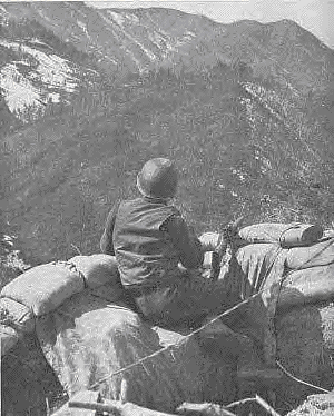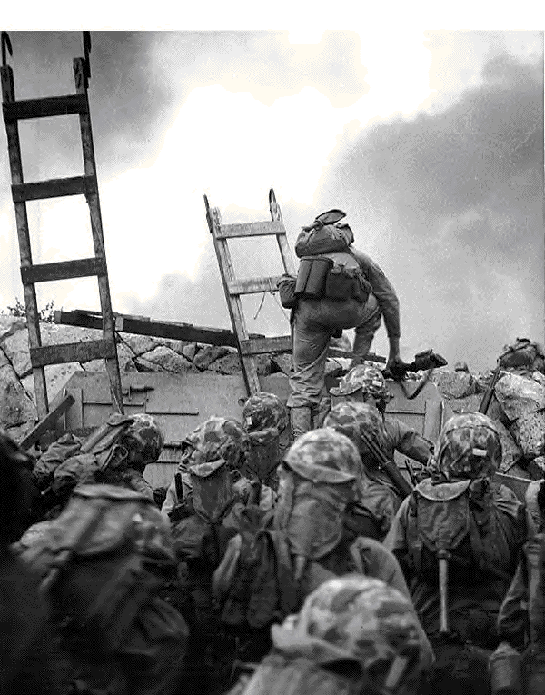Korean War
50th Anniversary of
the Pusan Perimeter
Counter Offensive
THIS MEMORIAL IS DEDICATED
TO THE MARINES AND SAILORS OF THE
5TH MARINE REGIMENT, "THE FIRE BRIGADE",
WHO FOUGHT AND GAVE THEIR LIVES
DURING COUNTER OFFENSIVES AT THE
PUSAN PERIMETER, KOREA, AUG - SEPT 1950
SOUTHWESTERN FRONT - NAKTONG I - NAKTONG II
DEDICATED ON 19 AUGUST 2000
The start of the finest saga in the history of the Marine Corps, by as fine a group of fighting men as ever wore the uniform. Most of the men were young, and inexperienced, but they had gone through the finest training for infantry that our country had to offer. Moreover, their officers and NCOs were almost all WWII veterans, victorious in bitter battle against the fine Japanese armies. All were volunteers.
They all knew about the North Korean torture and mutilation of wounded US prisoners. But they also knew the Corps' tradition of not abandoning Marine wounded. In the 1st and 2nd Battles of the Naktong bulge, Inchon, the fighting around Seoul, the fight-out from Yudam-ni in the Reservoir, 50% or more of these men would be killed or wounded, lying in graves from Pusan to Chosin. But they would fight as a team, confident in themselves and in one another.
In those coming campaigns, they would truly conduct themselves in the highest tradition of the United States Marine Corps.
Immediate Time line for these Marines:
July 7, 1st Provisional Marine Brigade (5th Marines and Aircraft Group 33) formed at Camp Pendleton with 6,534 men
July 12, 1st Marine Brigade, left San Diego. 1st Prov Brgde was 6,534 strong.
Jul 20, President Truman calls up the entire Organized Marine Reserve.
Aug 2, 1st Marine Brigade arrives in Pusan.
Aug 3, MAG 33 flying missions from carriers.
Aug 7, Marines in first battle with North Koreans. First battle of the Naktong.
There were many more battles to come.
5th Marine Sniper in Punchbowl M1903A1/Unertl, 1951
|

In the late 1940's, General Omar Bradley concluded that "amphibious operations are a thing of the past." The Truman Administration, guided by Bradley and the JCS, had cut the Fleet Marine Force to 34,000 officers and men, giving a ground fighting strength of only six infantry battalions, and a total Corps strength of 74,279 officers and men. Eliminated were the two Marine divisions which would have surely enabled Eighth Army to meet and defeat the In Min Gun in the Pusan Perimeter. As it turned out, the single Marine RCT which still was capable of rapid deployment effectively saved the Perimeter, and South Korea, with its valiant defeats of the NK in the Naktong battles. With these troops as their fighting edge, augmented by mobilizing the Marine Corps reserves, the whole 1st Marine Division landed at Inchon and devastated the NK army altogether. Only the over-extension of Eighth Army into North Korea, without proper staging or fallback defenses in depth, lost the victory we had gained, when the Chinese entered the war.
Marine Rifle Platoon from E-2-5, 1st Marine Division, 8/50
I've chosen this platoon, one of the finest the United States ever produced, to represent all our fighting men in Korea ... there were a great many fine men, in all the services.
To mention just one other outstanding group, I would pay particular respect to the fighting comrades of the Marine Brigade in the Peninsula, the 27th Infantry Regiment, 24th Infantry Division.
The above pictured rifle platoon fought throughout the Pusan Perimeter battles, Inchon, and across the Han River to help in the recapture of Seoul.
They were part of the competent infantry force that was essential in stopping the North Koreans. Our air, armor and naval supremacy was vital, and inflicted terrible casualties on the NK, but in the end Korea would have been lost had we not men, with hand guns, who had the courage and will to fight and defeat the enemy on the ground, face to face. These were among the finest men who ever wore the uniform of the United States Marines.
The survivors of the vicious South Korean battles would need all their courage and will ... ahead of them China was preparing a huge veteran army that had proven itself in the terrible struggles of China's Civil War. These two brave armies would meet at the Chosin reservoir.
Inchon Invasion, September 1950 First Lieutenant Baldomero Lopez, USMC, leads the 3rd Platoon, Company A, 1st Battalion, 5th Marines over the seawall on the northern side of Red Beach, as the second assault wave lands, 15 September 1950. Wooden scaling ladders are in use to facilitate disembarkation from the LCVP that brought these men to the shore. Lt. Lopez was killed in action within a few minutes, while assaulting a North Korean bunker.
|

